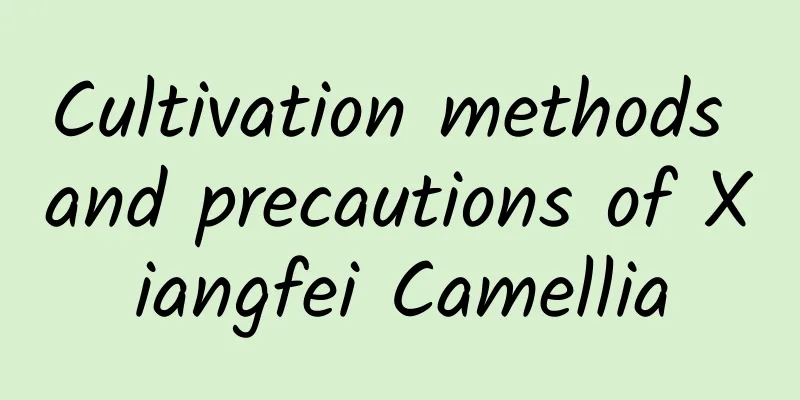Cultivation methods and precautions of Xiangfei Camellia

|
The maintenance of Xiangfei Camellia is very easy. It has a strong ability to adapt to the environment and is much easier to maintain than the native camellia. It can withstand temperatures as low as minus 10°C and can be planted in northern regions. It can be propagated by branch cuttings. In addition, it grows rapidly, has good branching, is resistant to pruning, and is easy to shape. It is also a good material for creating bonsai trees. Cultivation method of Xiangfei CamelliaXiangfei Camellia likes acidic soil. If the soil is alkaline, the leaves will turn yellow and the flowers will not bloom. Therefore, you can water the soil of the camellia once a month with ferrous sulfate solution or vinegar. During the growing and bud formation periods, you can expose it to more scattered light, which is conducive to the bud formation and flowering of the plant. The flowers are larger and the fragrance is stronger. In addition, the air is dry in autumn and winter, so you can frequently spray water mist on the leaves in a ventilated environment, which is beneficial to growth and flowering. 1. Soil: Xiangfei Camellia is a shallow-rooted plant with high requirements for soil. Choose loose, breathable, slightly acidic soil rich in humus, and short and fat ceramic pots for planting. The soil can be directly purchased as special soil for camellia, or mixed with leaf mold, garden soil, and perlite. 2. Lighting: Xiangfei Camellia is a light-loving plant. The light is mild in late autumn, so the plant can be placed outdoors in a well-lit place and given full sunlight. Adequate light is beneficial to leaf photosynthesis and energy accumulation, making the plant stronger and more conducive to the opening of flower buds in the later stage. 3. Water and fertilizer: The root system of Xiangfei Camellia is very weak and cannot tolerate heavy water or water accumulation in the pot. Therefore, it is best to water the camellia thoroughly at one time when the soil surface is dry. When watering in autumn and winter, do not use cold water directly. It is best to put the water in the sun for 1-2 days. Precautions for the maintenance of Xiangfei CamelliaBefore using the soil of Xiangfei Camellia, it should be exposed to the sun for 2 days to disinfect and sterilize it. When the plant enters the vigorous growth period, it needs to be given appropriate topdressing. When watering, the fertilizer and water should not stick to the leaves, otherwise the leaves will be easily burned. Xiangfei Camellia is easily infected by diseases and pests, especially anthracnose and black mold. It needs to be pruned frequently to increase the ventilation of the plant. |
<<: The cultivation methods and precautions of chive orchid
>>: Primrose cultivation methods and precautions
Recommend
How to breed Goldfinger
1. Cutting Many friends asked me: Can plants like...
Common Pests of Golden Button and Their Control Methods
Common Pests of Golden Button: Red Spider Red spi...
Causes and treatments for yellow leaves of Verbena
1. Improper fertilization 1. Reason: If the ferti...
How to make cucumber seeds germinate faster? How long does it take for seeds to germinate?
If cucumber seeds are sown at a temperature of 30...
Can asparagus fern be watered with beer water?
Can asparagus fern be watered with beer water? As...
Poria cocos planting conditions are suitable for growth of natural conditions
Introduction to Poria Poria, a traditional Chines...
What is straw?
What kind of crop is straw? Straw generally refer...
What is the value of the beautiful silk cotton tree
Practical Value of Silk Cotton Tree When the frui...
How to prune fuchsia
Shaping and pruning of fuchsia seedlings The so-c...
What are the cultivation methods and precautions of red diamond flowers?
Introduction of Red Diamond Flower The red diamon...
Placing flowers in the right position during the Chinese New Year can bring prosperity to the family and keep them safe.
Living room flowers Recommended flowers Cyclamen,...
How to propagate Pentaphyllum?
Pogostemon cablin can naturally release a pleasan...
When should Clivia be watered (how to judge when it is time to water Clivia)
How to judge whether it is time to water the Cliv...
Layering propagation of purple-leaf dwarf cherry
The layering time of purple-leaf dwarf cherry The...
How to divide roses
Rose division time Rose is a plant of the genus R...









